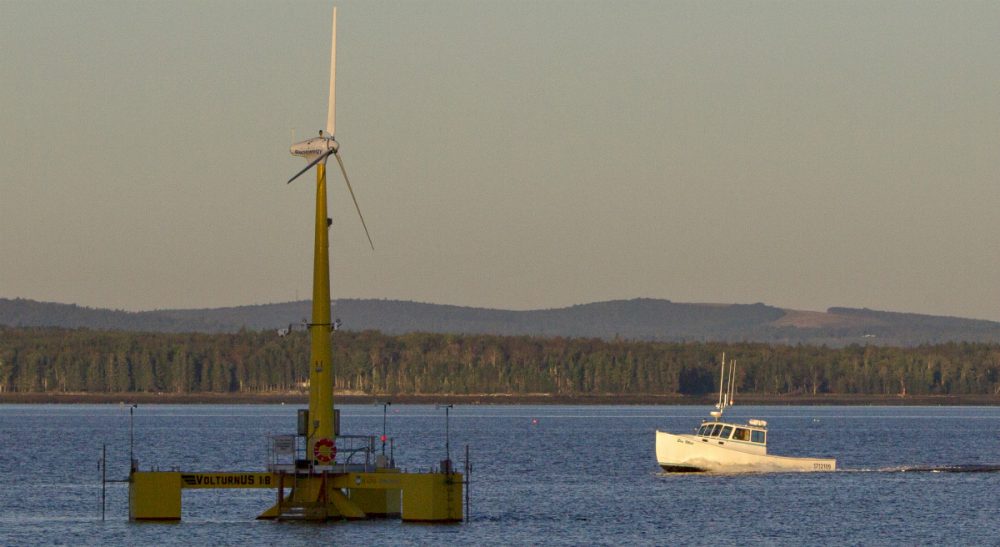Advertisement
The Coming Sea Change In Meeting New England's Energy Needs

New England and the sea are inseparable. Our identity rests on a legacy of seafaring, shipbuilding, fishing and trade. The deepest roots of our economy are in its maritime past.
The strong and steady ocean winds that blow on the Atlantic hold the potential to deliver abundant electricity to New England.
So it’s fitting that our energy future lies just off our coast. The strong and steady ocean winds that blow on the Atlantic hold the potential to deliver abundant electricity to New England. Because we can’t exploit vast open plains as other parts of the country can, our region turns to the sea. The wind is there for the taking. The technological obstacles between us and that mother lode of carbon-free power have already begun to fall away.
The first offshore wind farm in the Western Hemisphere is now under construction off Block Island. It’s a pilot project, just five turbines, each of which will generate six megawatts of power. That’s more than enough for Block Island, so the project includes undersea cables that will deliver the excess to Rhode Island’s grid. This isn’t a gauzy dream for the distant future. The steel foundations are in place, and the turbines are scheduled to spin in 2016.
The compelling logic of offshore wind makes you wonder what took us so long to catch on. In Europe, there are already 74 wind farms producing over 8,000 megawatts. On a breezy day in Denmark, offshore wind farms generate all the electricity the country needs, and they export what’s left over to Germany and Sweden.
But New England waters can be less hospitable to towering wind turbines than the North Sea. Violent northeast storms in winter and powerful hurricanes in the summer and fall present tough challenges for engineers. That increases costs. In a competitive global energy market, costs determine what gets built and what gets shelved.
Opportunely, the cost of offshore wind is coming down. Advances in technology are improving the reliability and efficiency of turbines. The arrival of larger, more efficient turbines means fewer of them are needed. And by reducing the amount of power lost in transmission to land, new cable technologies are enabling turbines to be sited less obtrusively, further offshore where winds are stronger. In Japan, they’re pioneering floating turbines that can be deployed in waters over 100 meters in depth. Innovation is driving a virtuous cycle of technological progress, as offshore wind inches towards price parity with fossil fuels.

We’ve already reached a tipping point. The players with the big money are ready to commit to offshore wind in New England. Three developers now have leases on ocean tracts south of Martha’s Vineyard that can accommodate hundreds of turbines. These companies bring both money and a depth of experience in wind power. One of the three, the Danish firm DONG Energy, already operates 16 wind farms in Europe that, together, can generate more than 2,000 megawatts. Looking at the New England coast, they see opportunity.
So now the dance between the public and private sectors begins. Developers are anxious to reap the profits from energy-hungry consumers. Politicians are anxious to secure jobs and power for their constituents. New England lawmakers face the challenge of establishing favorable economic conditions without giving away too much to the developers. Nearby states, such as New Jersey, are in the game as well.
...offshore wind could be the dominant source of energy in our region by 2050.
Coincidentally, legislators in the Massachusetts State House are in the process of putting together a comprehensive energy bill. The legislation is a goulash made with a diverse mix of energy flavors -- solar, wind, hydro and natural gas. If the politics play out as observers expect, the bill will carve out requirements for utilities to purchase a modest amount of power from offshore wind farms. Wind developers are attracted to the idea of a guaranteed market. And the plan is especially popular in job-starved southeastern Massachusetts, where the state’s largest coal-fired power generation plant is scheduled to close soon.
As has been true throughout its history, New England’s prospects seem bound to the sea. A 2014 study from Stanford University predicts that offshore wind could be the dominant source of energy in our region by 2050. New Englanders should embrace the change. Spurning the dirty fuels of the past, we should trust the ocean to provide for us as it always has.
